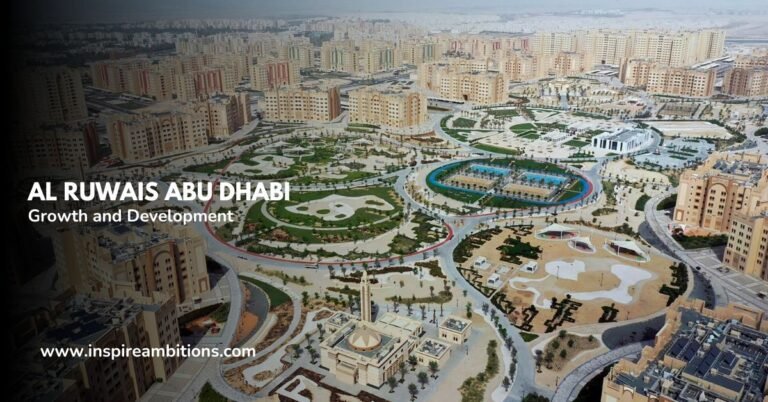What is Abu Dhabi’s Old Name? Uncovering the Emirate’s Rich History
Abu Dhabi, the capital of the United Arab Emirates (UAE), is a modern metropolis known for its stunning skyscrapers, luxurious hotels, and vibrant culture. However, this city has a fascinating history that dates back centuries. In this article, we’ll explore the old name for Abu Dhabi, its founding father, and other intriguing facts about this emirate’s past.
The Old Name for Abu Dhabi
Before it was known as आबू धाबी, the emirate was called “Milh,” which means “salt” in Arabic. This name was given due to the salt flats surrounding the area, which were a crucial source of income for the local population. The name “Abu Dhabi” means “Father of the Gazelle,” which, according to legend, refers to the founder of the emirate, Sheikh Dhiyab bin Isa.
The Father of Abu Dhabi
Sheikh Dhiyab bin Isa is considered the father of Abu Dhabi. He was a member of the Bani Yas tribe, which was the dominant tribe in the region during the 18th century. Sheikh Dhiyab is credited with establishing the first settlement in what is now known as Abu Dhabi in 1761. This settlement was on the island of Abu Dhabi, a strategic location for trade and pearling.
The Chinese Name for Abu Dhabi
In Chinese, Abu Dhabi is known as 阿布扎比 (Ābùzhābǐ). This transliteration is based on pronouncing the city’s name in Arabic. As the UAE and China continue strengthening their economic and cultural ties, it’s becoming increasingly common to see Chinese translations of Emirati city names.
The Oldest City in Abu Dhabi
The oldest city in the Emirate of Abu Dhabi is Al Ain, located in the eastern region of the emirate, near the border with Oman. Al Ain is known as the “Garden City” due to its lush oases and numerous parks. The city’s history dates back over 4,000 years, with evidence of human settlement from the Neolithic period.
Languages Spoken in Abu Dhabi
Although Arabic is the official language of the UAE, English is widely spoken in Abu Dhabi, especially in business and tourism contexts.
This is due to the emirate’s large expat population, a significant portion of the total population. Other languages commonly heard in Abu Dhabi include Hindi, Urdu, Tagalog, and Farsi, reflecting the diversity of the city’s residents.
Why is Abu Dhabi so Big?
Abu Dhabi is the largest emirate in the UAE, accounting for approximately 87% of the country’s total land area. The emirate’s size can be attributed to its vast desert landscape, which includes the Rub’ al Khali (Empty Quarter), the world’s largest contiguous sand desert.
Abu Dhabi’s significant oil reserves have also played a role in its growth and development, enabling the emirate to invest in infrastructure, real estate, and tourism projects.
Who Owned Abu Dhabi?
Before the formation of the UAE in 1971, the Al Nahyan family ruled Abu Dhabi, descendants of the Bani Yas tribe. Sheikh Zayed bin Sultan Al Nahyan, the UAE’s founding father, was Abu Dhabi’s ruler from 1966 until he died in 2004. Under his leadership, Abu Dhabi transformed from a small fishing and pearling village into a modern, prosperous city.
The Two-Word Capital of the United Arab Emirates
Abu Dhabi is the capital of the United Arab Emirates, a federation of seven emirates established in 1971. The city’s name consists of two words: “Abu,” which means “father,” and “Dhabi,” which is believed to refer to a species of native gazelle that once inhabited the area.
Today, Abu Dhabi is known for its modern architecture, cultural attractions, and thriving business district.
The Second Largest Emirate in the UAE
After Abu Dhabi, the second largest emirate in the UAE is Dubai. While Abu Dhabi is the capital and political centre of the country, Dubai is known for its iconic skyscrapers, luxurious hotels, and vibrant tourism industry.
Together, Abu Dhabi and Dubai are the core of the UAE’s economy and are the most popular destinations for expats and visitors.
What was the UAE Called Before 1971?
Before the formation of the United Arab Emirates in 1971, the seven emirates that now make up the country were known as the Trucial States. This name was derived from a series of treaties signed between the British government and the rulers of the individual emirates in the 19th and early 20th centuries.
These treaties granted the British control over foreign affairs and defence in exchange for protection against foreign aggression and internal unrest.
The Trucial States – A Brief History
The Trucial States consisted of Abu Dhabi, Dubai, Sharjah, Ajman, Umm Al Quwain, Ras Al Khaimah, and Fujairah. Each emirate was ruled by a different tribe, with the Al Nahyan family ruling Abu Dhabi and the Al Maktoum family ruling Dubai. The economies of the Trucial States were primarily based on pearling, fishing, and maritime trade.
In the 1950s and 1960s, the discovery of oil in the region began to transform the Trucial States. As oil revenues increased, the emirates’ rulers were able to invest in infrastructure, education, and healthcare, laying the foundation for the modern development of the UAE.
The Formation of the United Arab Emirates
In 1968, the British government announced its intention to withdraw from the Trucial States by 1971. This decision prompted the emirates’ rulers to begin negotiations on forming a federation.
On December 2, 1971, six Trucial States (Abu Dhabi, Dubai, Sharjah, Ajman, Umm Al Quwain, and Fujairah) agreed to form the United Arab Emirates. Ras Al Khaimah joined the federation in early 1972.
Abu Dhabi’s Role in the UAE
As the capital of the UAE, Abu Dhabi plays a central role in the country’s political, economic, and cultural affairs. The city is home to the UAE’s federal government and is the seat of the country’s President, who was traditionally the ruler of Abu Dhabi.
Abu Dhabi’s oil wealth has enabled the emirate to contribute significantly to the development of the UAE, investing in infrastructure, education, and social welfare programs.
Discovering Abu Dhabi’s Rich History
For expats living in Abu Dhabi or those considering a move to the emirate, understanding its history can provide valuable insights into the city’s culture and society. By exploring the old name of Abu Dhabi, learning about its founding father, and discovering its role in the formation of the UAE, expats can gain a deeper appreciation for the emirate’s rich heritage and dynamic present.
Interactive Timeline: Abu Dhabi’s History
Explore key events and milestones in Abu Dhabi’s history with our interactive timeline, from establishing the first settlement to forming the UAE and the emirate’s modern development.
Expat Experiences: Living in Abu Dhabi
Read personal stories and insights from expats living in Abu Dhabi as they share their experiences navigating the city’s culture, history, and modern way of life.
By engaging with these resources and immersing themselves in Abu Dhabi’s fascinating history, expats can develop a deeper connection to the city and its people, enriching their experience living in this vibrant and dynamic emirate.






